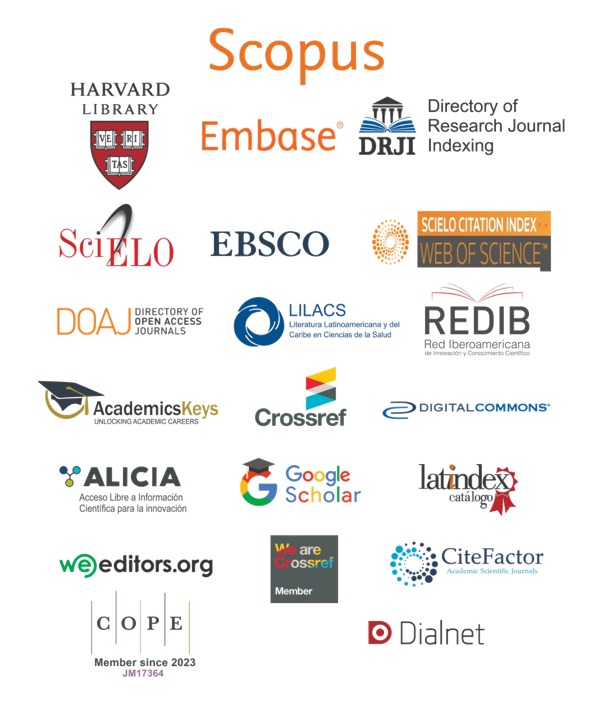Content validity by expert judgment of the NIOSH Worker Well-Being Questionnaire in Spanish for measuring Well-being in wildfire fighters in Mexico
Validez de contenido por juicio de expertos del NIOSH Worker Well-Being Questionnaire en Español para medir el Bienestar en combatientes de incendios forestales en México | 墨西哥森林火灾扑救队员中 NIOSH 工作者福祉问卷的西班牙语内容效度
Keywords:
Surveys and Questionnaires, Validation Study, Wildfires, Firefighters, Working ConditionsAbstract
Introduction: Firefighting in forests is a dangerous and demanding task, highlighting the need to understand the well-being of these workers through tools such as the NIOSH Worker Well-Being Questionnaire in Spanish. However, this questionnaire has not been adapted and validated for the Mexican context.
Objective: The study aimed to validate the NIOSH Worker Well-Being Questionnaire in Spanish for forest firefighters in Mexico.
Methods: A psychometric design was used, including content validation through expert judgment in validation, health, and work activities related to firefighting. The questionnaire incorporates five domains with a Likert scale, and the Aiken's V coefficient was used for validation.
Results: Most items in the questionnaire showed an Aiken's V coefficient above 0.70, with 95% confidence intervals, indicating high content validity. There was concordance with the original validation of the instrument, enabling its application in the Mexican work context.
Conclusion: The expert validation confirmed the relevance, coherence, and clarity of the NIOSH Worker Well-Being Questionnaire in Spanish for forest firefighters in Mexico. This analysis is a critical component of a broader project, laying the groundwork for subsequent stages including a pilot test and factorial analysis, as well as contributing to improving the safety and quality of life of these workers.
Downloads
References
U.S. Fire Administration. Firefighter Fatalities in the United States (2022). Disponible en: https://apps.usfa.fema.gov/firefighter-fatalities/
CONAFOR, Comisión Nacional Forestal (2018), Nos llaman combatientes. Disponible en: https://www.gob.mx/conafor/articulos/nos-llaman-combatientes
Moody, V.J., Purchio, T.J., & Palmer, C. (2019). Descriptive analysis of injuries and illnesses self-reported by wildland firefighters. International Journal of Wildland Fire. doi:10.1071/WF18132
Butler, C.R., Marsh, S.M., Domitrovich, J.W., & Helmkamp, J.C. (2017). Wildland firefighter deaths in the United States: A comparison of existing surveillance systems. Journal of Occupational and Environmental Hygiene, 14, 258 - 270. doi:10.1080/15459624.2016.1250004
Chari, R., Chang, C. C., Sauter, S. L., Petrun Sayers, E. L., Huang, W., & Fisher, G. G. (2021). NIOSH worker well-being questionnaire (WellBQ). U.S. Department of Health and Human Services, Centers for Disease Control and Prevention, National Institute for Occupational Safety and Health. doi:10.26616/NIOSHPUB2021110revised52021
Chari, R., Sauter, S. L., Petrun Sayers, E. L., Huang, W., Fisher, G. G., & Chang, C. C. (2022). Development of the National Institute for Occupational Safety and Health Worker Well-Being Questionnaire. Journal of occupational and environmental medicine, 64(8), 707–717. doi:10.1097/JOM.0000000000002585
Fontana, L. D., Pasquale; Santocono, Carolina; Annarumma, Maddalena; Iavicoli, Ivo. (2023). Validation of the NIOSH Worker Well-Being Questionnaire in Italian Language. Journal of occupational and environmental medicine, 65(6), e402-e412. doi:10.1097/jom.0000000000002835
Schulte, P. A., Guerin, R. J., Schill, A. L., Bhattacharya, A., Cunningham, T. R., Pandalai, S. P., Eggerth, D., & Stephenson, C. M. (2015). Considerations for Incorporating "Well-Being" in Public Policy for Workers and Workplaces. American journal of public health, 105(8), e31–e44. doi:10.2105/AJPH.2015.302616
Dunn, J. G. H., Bouffard, M., & Rogers, W. T. (1999). Assessing content-relevance in sport psychology scale-construction research: Issues and recommendations.Measurement in Physical Education and Exercise Science, 3,15–36. doi:10.1207/s15327841mpee0301_2
Aiken, L. R. (1980). Content Validity and Reliability of Single Items or Questionnaires. Educational and Psychological Measurement, 40(4), 955-959. doi:10.1177/001316448004000419
Aiken, L. R. (1985). Three Coefficients for Analyzing the Reliability and Validity of Ratings. Educational and Psychological Measurement, 45(1), 131-142. doi:10.1177/0013164485451012
Penfield Randall D; Giacobbi, Peter R.. (2004) Applying a Score Confidence Interval to Aiken's Item Content-Relevance Index, Measurement in Physical Education and Exercise Science, 8:4, 213-225, doi:10.1207/s15327841mpee0804_3
Hamar, B., Coberley, C., Pope, J. E., & Rula, E. Y. (2015). Well-being improvement in a midsize employer: changes in well-being, productivity, health risk, and perceived employer support after implementation of a well-being improvement strategy. Journal of occupational and environmental medicine, 57(4), 367–373. doi:10.1097/JOM.0000000000000433
Vendrig, A. A., & Schaafsma, F. G. (2018). Reliability and Validity of the Work and Well-Being Inventory (WBI) for Employees. Journal of occupational rehabilitation, 28(2), 377–390. doi:10.1007/s10926-017-9729-7
Hagan-Haynes, K. M., Virginia; Puma, Jini; Farewell, Charlotte. (2024). Caring for the Caregiver: Work Mistreatment and Well-Being Among Early Childhood Education Staff in Colorado. Early Childhood Education Journal. doi:10.1007/s10643-024-01644-6
Ventura-León, J. (2020). Escalas, inventarios y cuestionarios: ¿son lo mismo? Educación Médica, 21(3), 218-220. doi:10.1016/j.edumed.2019.04.001
Simms, L. J., Zelazny, K., Williams, T. F., & Bernstein, L. (2019). Does the number of response options matter? Psychometric perspectives using personality questionnaire data. Psychological assessment, 31(4), 557–566. doi:10.1037/pas0000648
Torres-Malca, J. R., Vera-Ponce, V. J., Zuzunaga-Montoya, F. E., Talavera, J. E., & De La Cruz-Vargas, J. A. (2022). Validez de contenido por juicio de expertos de un instrumento para medir conocimientos, actitudes y prácticas sobre el consumo de sal en la población peruana. Revista de la Facultad de Medicina Humana, 22(2), 273-279. doi:10.25176/rfmh.v22i2.4768
Merino-Soto, C. (2018). Confidence interval for difference between coefficients of content validity (Aiken’s V): A SPSS syntax. [Intervalos de confianza para la diferencia entre coeficientes de validez de contenido (V Aiken): Una sintaxis SPSS] Anales De Psicología, 34(3), 587-590. doi:10.6018/analesps.34.3.283481
Dieguez-Reyes E, Valdés-Santiago D. Validez de contenido de la escala RED-Tecnoestrés en el sector informático cubano. La Habana, 2023. Revista Cubana de Salud y Trabajo [Internet]. 2023 [citado 17 Nov 2023]; 25 (1) Disponible en: https://revsaludtrabajo.sld.cu/index.php/revsyt/article/view/403
Koopmans, E., Cornish, K., Fyfe, T. M., Bailey, K., & Pelletier, C. A. (2022). Health risks and mitigation strategies from occupational exposure to wildland fire: a scoping review. Journal of occupational medicine and toxicology (London, England), 17(1), 2. doi:10.1186/s12995-021-00328-w

Downloads
Published
How to Cite
Issue
Section
License
Copyright (c) 2024 Revista de la Facultad de Medicina Humana

This work is licensed under a Creative Commons Attribution 4.0 International License.





























